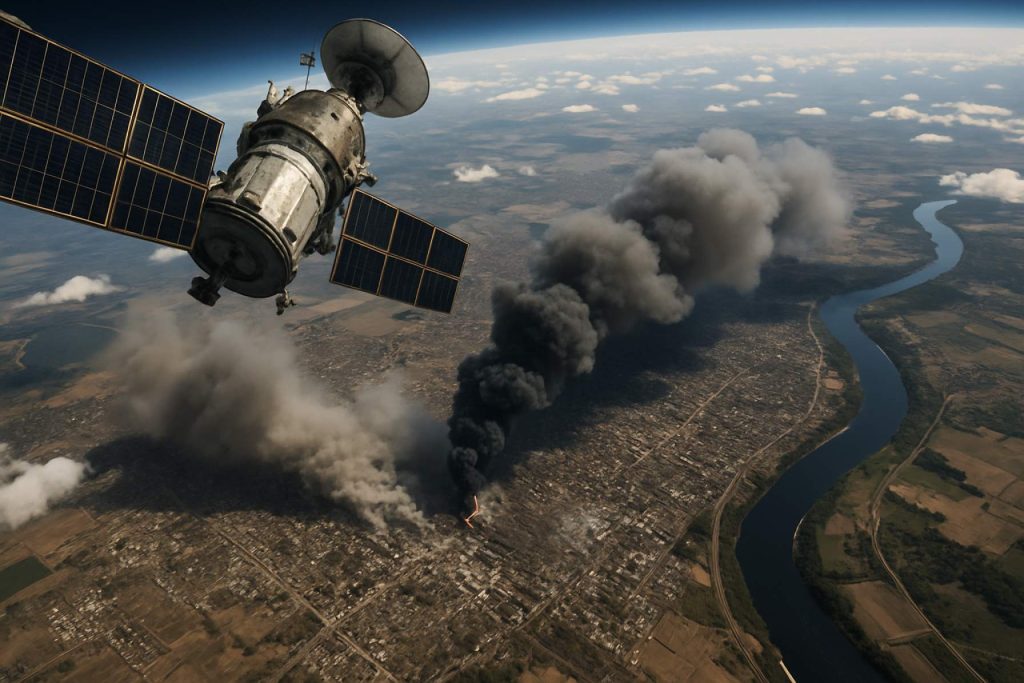
From Orbit to Peace Talks: How Satellites Could Transform Ukraine’s Next Ceasefire in 2025
Satellites are changing war and peacekeeping in Ukraine—here’s how cutting-edge space tech could anchor a future ceasefire.
- 28,000 km/h: Speed of imaging satellites orbiting above Ukraine
- 400 km: Length of Ukraine’s volatile ceasefire “line of contact”
- Dozens: Drones lost to hostile fire during frontline monitoring missions
- 2025 Trend: AI-powered satellites and drones now enable live battlefield updates
War has gone high-tech. Dazzling images snapped by satellites racing through space brought the Russian invasion of Ukraine to the world’s smartphones in real time. Ukrainian defenders, outgunned and outnumbered, turned the tide with nimble drones—and with a steady eye from above. International audiences, from Parisian officials to Ivy League students, watched the drama unfold in crisp detail, courtesy of orbiting cameras.
But the impact of these “robotic photographers” now goes beyond public awareness. Security experts and peace scholars argue that satellites can steer the course of conflict—and even support fragile attempts at peace.
Q: How Did Satellites Shift the Dynamics of War in Ukraine?
The first wave of satellite images revealed Russian tanks storming Ukraine’s borders and later retreating under drone attack. These high-flying witnesses raced overhead at 28,000 kilometers per hour, broadcasting not only evidence of violence but also the resilience of Ukraine’s defenders. The relentless stream of satellite data provided both military intelligence and global transparency—a vital counter to misinformation campaigns.
Q: Can Satellites Keep the Peace If Human Monitors Can’t?
Ceasefire missions in Ukraine, including those overseen by the Organization for Security and Cooperation in Europe (OSCE), often hinge on neutral observers in the field. But with battle zones riddled with mines and targeted attacks, these teams have sometimes paid the ultimate price. In 2017, an American paramedic lost his life to a landmine during a peacekeeping patrol. The risks forced a new reliance on satellite and drone imagery to cover the 400-kilometer “line of contact” between warring sides.
Dr. Valerie Sticher of ETH Zurich explains that in high-risk combat areas, satellites can do what humans cannot—safely monitor, verify, and document armed activity in real time. These tools have already deterred some ceasefire violations and protected observers from hidden dangers.
How Satellites Expose—and Deter—Ceasefire Violations
Satellite photos don’t just record history; they can serve as indisputable evidence. Unlike witness testimonies, photos from orbit are harder to challenge, which is crucial when belligerents deny breaches or launch disinformation campaigns. In earlier years, satellite snaps revealed sudden minefields and troop deployments—allowing OSCE teams to reroute and dodge fresh threats.
Planet Labs, a pioneer in the “NewSpace” race, and Maxar Technologies provided images proving troop movements, damage to infrastructure, and humanitarian crises. AI now helps process this flood of imagery, flagging missile batteries and refugee flows quicker than ever.
Q: What Challenges Still Hinder Satellite-Based Peacekeeping?
Despite their promise, satellites and drones don’t guarantee safety or compliance. Ceasefire parties have grown skilled at camouflage, concealing weapons before satellite overpasses. Many drones have been shot down during monitoring missions. OSCE studies show that resistance to outside observation remains one of the biggest obstacles to peace.
Moreover, satellites complement but cannot fully replace humans on the front lines—especially when it comes to negotiating local truces or assisting frightened civilians under fire.
How-To: Could Advanced Tech Finally Secure a Lasting Ceasefire in Ukraine?
– Combine satellite, UAV, and on-the-ground observer reports for maximum accuracy and safety.
– Use AI to detect unusual patterns—like new minefields or disguised equipment.
– Share unbiased satellite imagery with international negotiators to counter propaganda.
– Pressure all parties to allow unfettered access to peace monitors—human and robotic.
What’s Next? Global Powers Push for High-Tech Peace Talks
France, the European Union, and the United States are ramping up sanctions and diplomatic efforts to force Moscow into new ceasefire talks. With leadership from figures like U.S. Senator Lindsey Graham and French Foreign Minister Jean-Noël Barrot, Kyiv could soon see another chance for peace—but technology will play a starring role.
Even the Vatican’s new pope has called for negotiations, echoing a growing global wave of peace advocacy.
The world will be watching—often from space—as the next chapter of Ukraine’s struggle for peace unfolds.
Take Action: Five Ways to Prepare for a 2025 Tech-Savvy Ceasefire
- Support global transparency with open access to satellite imagery (Planet Labs, Maxar).
- Follow developments from leading space-tech organizations and peacekeeping agencies.
- Demand real-time, AI-enhanced monitoring for all future ceasefires.
- Push for international agreements mandating safe access for peacekeepers and their tech tools.
- Stay informed through reliable news sources like BBC and Reuters.
Stay tuned as satellites, drones, and cutting-edge tech redefine how the world confronts conflict—and pursues peace—in Ukraine and beyond.



